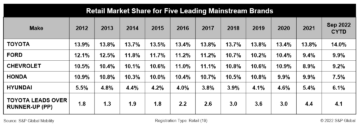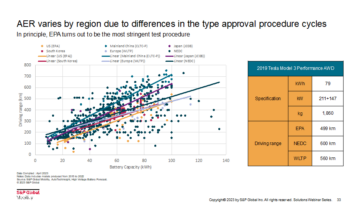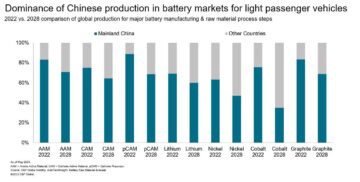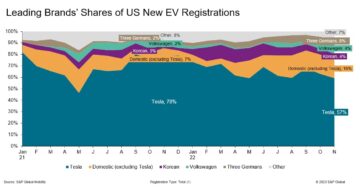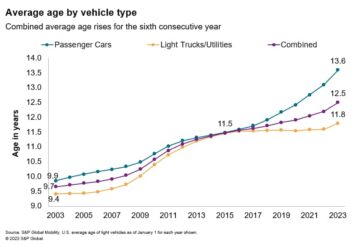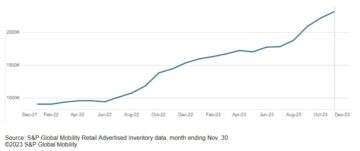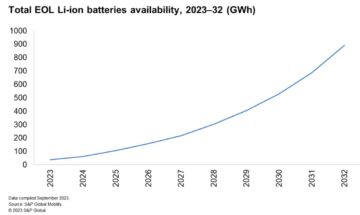
Post-COVID car buyers are willing to wait for the right car,
and want more of the process to be handled online. But they still
want test drives, according to a new survey.
A survey of US vehicle shoppers who bought cars in 2022 shows
that a clear majority would be willing to wait for a vehicle that
specifically met their tastes.
According to the Vehicle Buyer Journey survey recently conducted
by S&P Global Mobility, 56% of consumers in the US would be
willing to wait more than one month for delivery of an ordered
vehicle, and 30% would be willing to wait more than three months.
The percentages skew higher for those looking to buy a
luxury-branded model.
The S&P Global Mobility survey also found consumers are
desiring more of the purchase process to be handled online,
compared to results from a similar survey taken in mid-2020 of
consumers who had purchased vehicles during the pandemic
lockdown.
“We have seen that COVID-19 has changed consumer behavior. The
key is what the lasting changes will be,” said Treffen White,
director of consulting for S&P Global Mobility. “The dealer
network of the past is not necessarily the network the industry
will need for the future. Having the right digital tools will be
more important than the size or appearance of the showroom. And
this will impact how OEMs plan their physical locations for
dealerships.”
This runs counter to the long-standing dealership inventory
model that contends that Americans want to walk into a showroom and
buy a vehicle straight from the dealer’s lot that day. It also
represents a clear shift in consumer preferences that highlights
the retail transformation happening on a digital level.
The S&P Global survey showed that 70% of US customers were
willing to select a dealership further away from their homes
because the retailer allowed for more online purchase/comparison
options - female shoppers especially so. Up 8 percentage points
from pre-COVID, 60% of customers now expect their next vehicle
purchase to be completed entirely online.
“During their next vehicle purchase, two-thirds of people expect
to complete some part of the process online, specifically
paperwork,” White said. “Unfortunately, consumer pessimism
regarding the retailing process remains intact. Post-COVID, more
people also expect their next vehicle purchase process to become
more difficult.”
The top areas of vehicle transactions customers wish to conduct
online are negotiating vehicle price, F&I paperwork, arranging
test drives, and negotiating trade ins, according to the
research.
That transformation aside, 82% of car buyers still want to test
drive a representative model of their planned vehicle purchase
before putting down their deposits – nearly identical to the 84%
who had the same preference prior to the pandemic. What has
changed, however, is how many car shoppers want the test drive to
occur with the vehicle delivered to their home or office, instead
of at the dealership.
The number of home-delivery test drives has doubled between pre-
and post-COVID, according to the survey. And while the desire for a
test drive remains strong across all cohorts, younger customers are
more likely to want one. Males were more likely to participate in
in-dealership test drives, while females were more likely to
participate in alternative test drive options such as
home-delivery, virtual reality, or experience center test drives
rather than in-dealership test drives.
“There is a direct correlation between loyalty and inventory.
Now that inventories are returning, there is an opportunity for
OEMs and dealers to gain share,” White said. “Dealers embracing new
digital processes will be on the leading edge of consumer sentiment
for buying their next car, and this will drive loyalty
accordingly.”
The 1,450 respondents of this most recent survey were split
between 1,000 new-car buyers and 450 used-car buyers in the US over
the preceding 12 months. S&P Global Mobility also conducted
simultaneous surveys of car buyers in China, the United Kingdom,
Spain, Germany, Italy, and France.
This article was published by S&P Global Mobility and not by S&P Global Ratings, which is a separately managed division of S&P Global.
- SEO Powered Content & PR Distribution. Get Amplified Today.
- Platoblockchain. Web3 Metaverse Intelligence. Knowledge Amplified. Access Here.
- Source: http://www.spglobal.com/mobility/en/research-analysis/americans-appear-ready-for-the-european-carordering-model.html
- 000
- 1
- 12 months
- 2022
- a
- According
- accordingly
- across
- All
- alternative
- Americans
- and
- appear
- areas
- article
- because
- become
- before
- between
- bought
- buy
- buyers
- Buying
- car
- cars
- Center
- Changes
- China
- clear
- compared
- complete
- Completed
- Conduct
- consulting
- consumer
- consumer behavior
- consumer sentiment
- Consumers
- Correlation
- Counter
- COVID-19
- Customers
- day
- dealer
- delivered
- delivery
- deposits
- difficult
- digital
- direct
- Director
- Division
- doubled
- down
- drive
- during
- Edge
- embracing
- entirely
- especially
- Ether (ETH)
- European
- expect
- experience
- female
- females
- found
- France
- from
- further
- future
- Gain
- Germany
- Global
- having
- higher
- highlights
- Home
- Homes
- How
- However
- HTTPS
- identical
- Impact
- important
- in
- industry
- instead
- inventory
- IT
- Italy
- journey
- Key
- Kingdom
- leading
- Level
- likely
- locations
- lockdown
- long-standing
- looking
- Lot
- Loyalty
- Majority
- managed
- many
- mobility
- model
- Month
- months
- more
- most
- nearly
- necessarily
- Need
- network
- New
- next
- number
- Office
- ONE
- online
- Opportunity
- Options
- pandemic
- paperwork
- part
- participate
- past
- People
- percentage
- pessimism
- physical
- plan
- planned
- plato
- Plato Data Intelligence
- PlatoData
- points
- preferences
- price
- Prior
- process
- processes
- published
- purchase
- purchased
- Putting
- ratings
- ready
- Reality
- recent
- recently
- regarding
- remains
- representative
- represents
- research
- Results
- retail
- retailer
- retailing
- returning
- S&P
- S&P Global
- Said
- same
- sentiment
- Share
- shift
- Shoppers
- Shows
- similar
- simultaneous
- Size
- skew
- So
- some
- Spain
- specifically
- split
- Still
- straight
- strong
- such
- Survey
- test
- The
- The Future
- the United Kingdom
- their
- three
- to
- tools
- top
- trade
- Transactions
- Transformation
- two-thirds
- United
- United Kingdom
- us
- vehicle
- Vehicles
- Virtual
- Virtual reality
- wait
- What
- which
- while
- white
- WHO
- will
- willing
- would
- Younger
- zephyrnet



